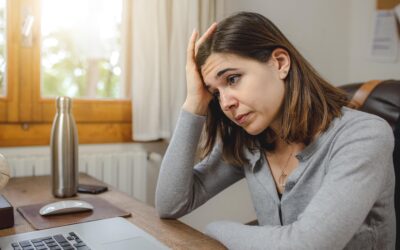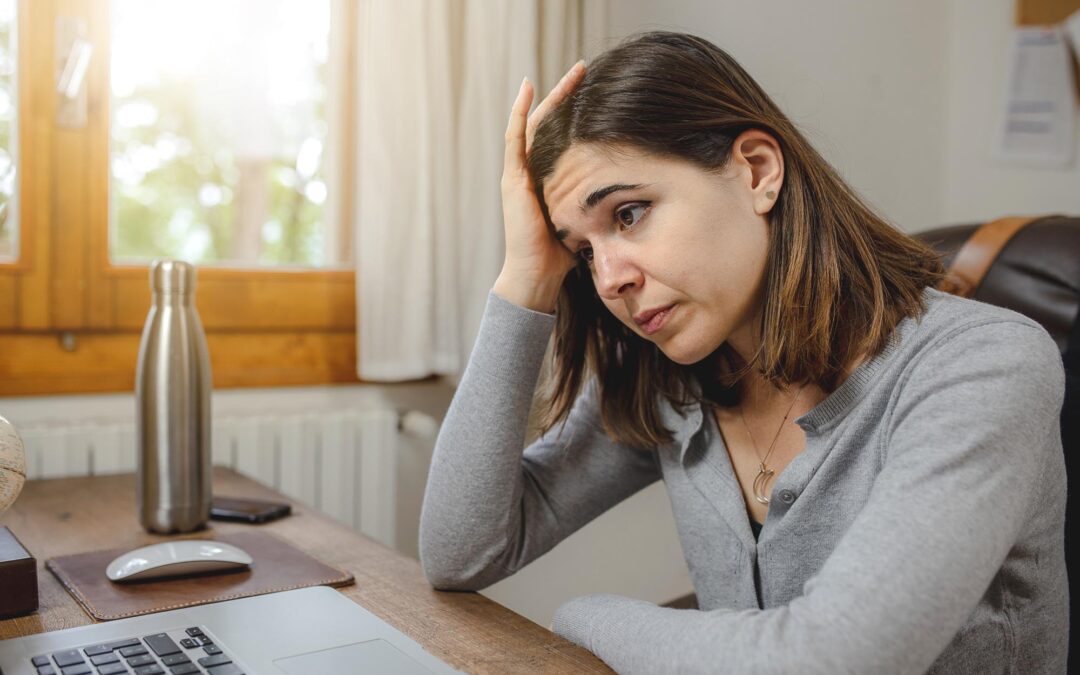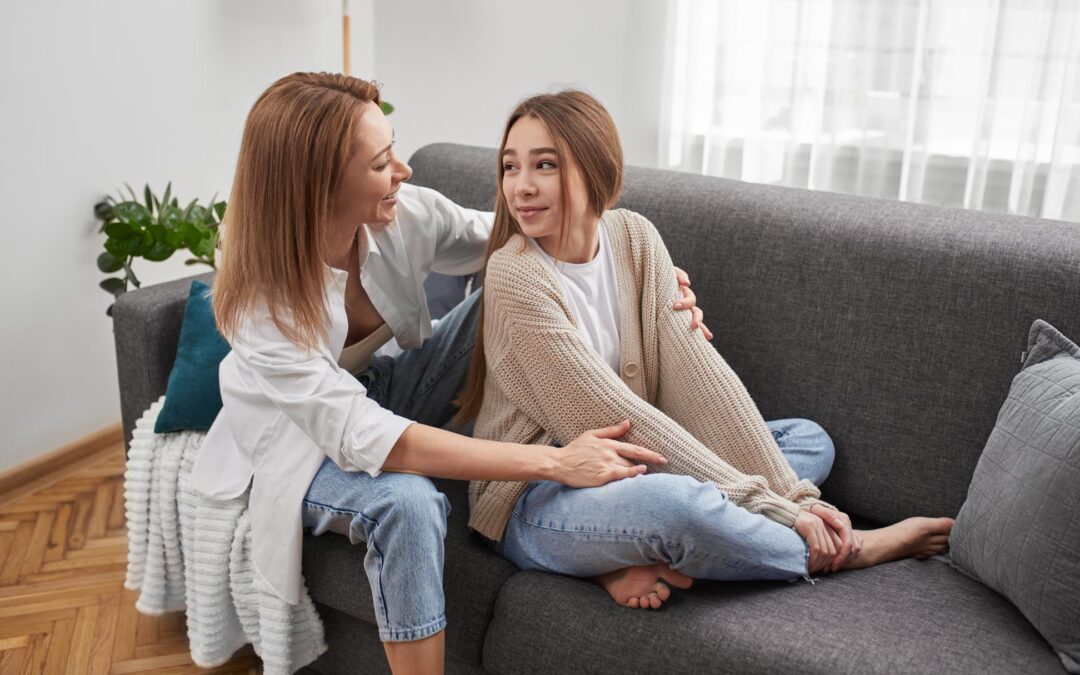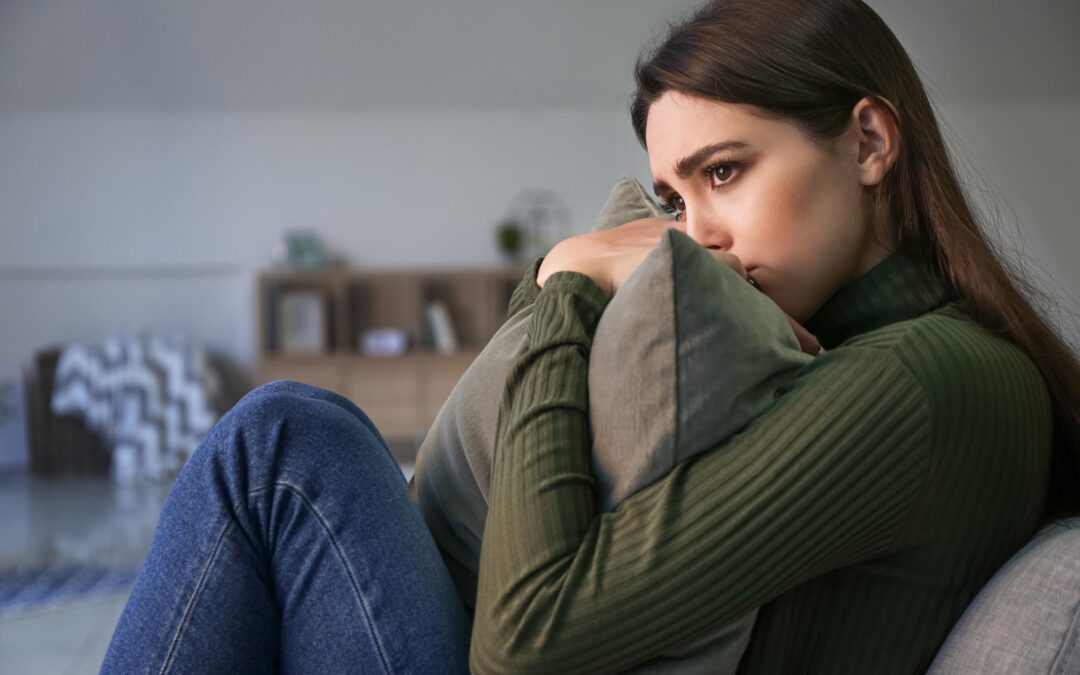Can Therapy Stop the Physical Anxiety Symptoms?
Understanding Physical Anxiety Symptoms
Your heart pounds like it’s trying to escape your chest. Your palms are slick with sweat, and that familiar knot in your stomach makes you feel like you might be sick. If this sounds familiar, you’re not alone – these physical symptoms of anxiety affect millions of women every day.
Anxiety doesn’t just live in your mind; it takes up residence in your entire body. The most common physical manifestations include:
- Rapid heartbeat or heart palpitations
- Headaches ranging from tension to migraine-like pain
- Muscle tension, especially in shoulders, neck, and jaw
- Nausea or digestive upset
- Sweating or hot flashes
- Shortness of breath
- Dizziness or lightheadedness
- Trembling or shaking
But why does anxiety create such intense bodily reactions? The answer lies in your autonomic nervous system – the part of your nervous system that controls involuntary functions like breathing and heart rate. When anxiety strikes, it triggers your body’s ancient fight-or-flight response, flooding your system with stress hormones like adrenaline and cortisol.
This response was designed to help our ancestors escape immediate physical danger. Your heart races to pump blood to your muscles, you sweat to cool down, and your digestive system slows to conserve energy for “survival.” While this system served us well when facing wild animals, it’s less helpful when dealing with modern stressors like work deadlines or relationship concerns.
In fact, these stressors can significantly impact women’s mental health in the workplace, leading to a need for mental health days more often than not. It’s crucial to understand that these physical symptoms are a part of a larger picture that includes anxiety as a mental health disorder. If you’re struggling with these symptoms, don’t hesitate to reach out for help through our contact page.
How Therapy Can Help Break the Cycle of Physical Anxiety Symptoms
When your heart races and your palms sweat, it’s natural to feel even more anxious about these sensations. This creates what therapists call the anxiety-symptom cycle – where physical symptoms trigger more worry, which then intensifies the physical responses. The good news? The benefits of therapy go beyond just talking about your feelings; they actively work to break this exhausting loop.
Understanding the Anxiety-Symptom Cycle
The anxiety-symptom cycle is a pattern that many people experience when dealing with anxiety. Here’s how it works:
- Physical Symptoms: You may experience physical symptoms such as a racing heart, sweaty palms, or shortness of breath.
- Increased Worry: Instead of feeling calm and accepting these sensations, you become more anxious about them.
- Intensified Physical Responses: As a result of this increased worry, your body responds with even stronger physical reactions.
This cycle can be incredibly draining and can make it difficult to manage your anxiety.
How Therapy Can Help
Therapy offers a way to interrupt this cycle and bring about positive change. Here’s how it works:
- Reducing Physical Arousal: Professional therapists focus on reducing the physical responses associated with anxiety by teaching your nervous system new ways to react to stress.
- Retraining Your Body’s Alarm System: Think of therapy as a way to retrain your body’s alarm system. Instead of constantly being on high alert, therapy helps you find a state of calm awareness.
- Targeting Thoughts and Physical Responses: The most effective therapeutic approaches target both your thoughts and your physical reactions at the same time.
The Benefits of Combined Approaches
By addressing both the psychological and physiological aspects of anxiety symptoms, you’re not just managing the problem – you’re actually rewiring your body’s stress response system. Here’s why this combined approach is important:
- Mental Strategies: These strategies, often learned through comprehensive mental health treatment, help you understand and reframe anxious thoughts.
- Physical Techniques: These techniques, which can be part of an outpatient program for anxiety, provide immediate relief from symptoms like muscle tension and rapid breathing.
- Lasting Change: By combining mental and physical approaches, you create lasting change in how your body responds to stress.
Tools for Real-Time Relief
One of the key benefits of therapy is that it provides you with tools that work in real-time when symptoms arise. Here are some examples:
- Relaxation Techniques: These techniques directly counteract the fight-or-flight response and help calm your body down.
- Cognitive Restructuring: This process involves identifying and challenging negative thought patterns that contribute to anxiety.
With these tools at your disposal, you’ll be better equipped to handle anxious situations and prevent the cycle from continuing.
For instance, incorporating brief cognitive behavioral therapy (CBT) techniques can significantly help in breaking this cycle by offering practical strategies that address both thoughts and physical responses simultaneously. Moreover, understanding the [physiological aspects](https://www.ncbi.nl
1. Cognitive Behavioral Therapy (CBT) for Addressing Physical Anxiety Symptoms
CBT for anxiety operates on a simple yet powerful principle: our thoughts, feelings, and physical sensations are deeply interconnected. When your heart starts racing during a presentation, CBT helps you recognize how catastrophic thoughts like “Everyone will notice I’m sweating” can intensify those very physical symptoms you’re trying to avoid.
The beauty of cognitive restructuring lies in its detective-like approach. Your therapist will guide you through identifying the specific thought patterns that amplify your body’s stress response. Maybe you’ve noticed that thinking “I can’t handle this racing heart” actually makes your pulse quicken even more. Through CBT, you’ll learn to catch these thoughts in real-time and replace them with more balanced alternatives like “This feeling is temporary and my body knows how to calm down.”
Coping strategies developed through CBT become your personal toolkit for managing physical symptoms:
- Thought challenging: Questioning the evidence behind anxiety-provoking thoughts
- Behavioral experiments: Testing whether your feared physical reactions actually occur
- Symptom tracking: Recording patterns between thoughts and bodily sensations
- Grounding techniques: Using your five senses to anchor yourself during physical anxiety spikes
These 6 Ways Therapy Can Stop Physical Anxiety Symptoms through CBT create lasting change because they address the root cause rather than just masking symptoms. You’re essentially rewiring your brain’s response to physical sensations, transforming them from threats into manageable experiences.
2. Exposure Therapy: Reducing Sensitivity to Anxiety Triggers and Physical Reactions Over Time
Exposure therapy is like gradually getting used to what scares you the most. It is an evidence-based method that works by carefully and systematically exposing you to anxiety triggers in a controlled and supportive environment. With the help of your therapist, you will go through this process, starting with less threatening situations and gradually progressing to more difficult ones.
How Exposure Therapy Works
The magic happens through desensitization to triggers – your nervous system learns that these situations aren’t actually dangerous. Each time you face a trigger without experiencing the disastrous outcome your anxiety predicted, your brain rewires itself. The racing heart, sweating palms, and muscle tension that once felt overwhelming begin to lose their intensity.
The Benefits of Exposure Therapy
Research consistently demonstrates the exposure therapy benefits for physical anxiety symptoms. Studies show that people who complete exposure therapy experience significant reductions in:
- Heart rate spikes during anxiety-provoking situations
- Muscle tension and physical rigidity
- Gastrointestinal symptoms like nausea
- Excessive sweating and trembling
One study found that 70% of participants showed marked improvement in physical anxiety symptoms after just 12 weeks of exposure therapy. The beautiful part? These improvements often last long after therapy ends because you’ve literally retrained your body’s stress response system.
Your body learns to trust that you can handle difficult situations, creating lasting change that goes far beyond the therapy room.
3. Mind-Body Interventions: Using Relaxation Techniques to Soothe Both Body and Mind During Stressful Situations or Panic Attacks
Your body has an amazing ability to heal from anxiety. Mind-body interventions tap into this natural ability, offering powerful tools to interrupt the physical symptoms of anxiety before they get out of control.
1. Deep breathing exercises
Deep breathing exercises are your first line of defense against racing hearts and shallow breathing. The 4-7-8 technique—inhaling for 4 counts, holding for 7, and exhaling for 8—activates your parasympathetic nervous system, literally telling your body it’s safe to relax.
2. Progressive muscle relaxation
Progressive muscle relaxation teaches you to recognize and release tension you might not even realize you’re carrying. Start with your toes, deliberately tensing each muscle group for 5 seconds before releasing. This practice helps you become more aware of physical stress signals throughout your day.
3. Meditation for anxiety
Meditation for anxiety doesn’t require hours of sitting cross-legged. Even 5-minute guided meditations can rewire your brain’s response to stress. Apps like Headspace or Calm offer anxiety-specific programs that fit into busy schedules.
4. Yoga for anxiety
Yoga for anxiety combines movement, breath, and mindfulness in one practice. Gentle poses like child’s pose or legs-up-the-wall can provide immediate relief during anxious moments.
While these techniques can be incredibly helpful, it’s important to recognize when professional help may be needed. Prioritizing your mental health is essential, especially if anxiety becomes overwhelming or unmanageable.
Making it work for you:
- Practice these techniques when you’re calm, not just during panic
- Keep a “toolkit” of 2-3 favorites for quick access
- Set phone reminders for brief practice sessions
- Create a designated calm space in your home
4. Lifestyle Factors That Influence Physical Anxiety Symptoms: The Importance Of Taking Care Of Your Body And Mind Outside Of Therapy Sessions Too!
Your daily choices create a powerful foundation for managing physical anxiety symptoms. The connection between lifestyle changes for anxiety and symptom relief runs deeper than you might realize – what you eat, how you move, and when you sleep directly impacts your nervous system’s ability to stay regulated.
Exercise and diet for mental health work as natural anxiety regulators. Regular physical activity helps metabolize stress hormones like cortisol and adrenaline while boosting mood-stabilizing endorphins. Even a 20-minute walk can shift your body from fight-or-flight mode into a calmer state. Consistent exercise also improves sleep quality, which directly affects how intensely you experience physical anxiety symptoms the next day.
Nutrition plays an equally vital role. Blood sugar spikes and crashes can mimic anxiety symptoms – that racing heart after too much caffeine or the shaky feeling when you skip meals. Stable blood sugar through balanced meals helps prevent these anxiety-like sensations.
Simple daily habits that support anxiety management:
- Start your morning with protein to stabilize blood sugar
- Limit caffeine to before 2 PM to protect sleep quality
- Take short movement breaks every few hours
- Stay hydrated throughout the day
- Create a consistent sleep schedule
These 6 Ways Therapy Can Stop Physical Anxiety Symptoms become even more effective when supported by nurturing lifestyle choices that honor both your body and mind. Incorporating healthy habits into your routine can further enhance your mental well-being and help alleviate anxiety symptoms.
5. When Medication May Complement Therapy in Managing Acute Physical Symptoms While Building Long-Term Coping Skills Through Treatment
Sometimes your body needs immediate relief while your mind learns new coping strategies. Medication for anxiety symptoms can serve as a bridge, providing the breathing room you need to engage fully in therapeutic work when physical symptoms feel overwhelming.
Benzodiazepines like lorazepam or clonazepam work quickly to calm your nervous system during intense panic episodes. Your racing heart slows, that crushing chest tightness eases, and the trembling subsides. These medications can be particularly helpful when:
- Physical symptoms are so severe they prevent you from sleeping or functioning
- You’re starting therapy and need stabilization to participate effectively
- Panic attacks are frequent and debilitating
Beta-blockers such as propranolol target specific physical symptoms like rapid heartbeat, sweating, and trembling. Many women find these especially useful for performance anxiety or social situations where physical symptoms feel most noticeable.
The key lies in viewing medication as a temporary support system rather than a permanent solution. While these medications address the immediate physical distress, therapy builds the lasting skills your mind needs to prevent and manage anxiety long-term. Your healthcare provider can help determine if this combined approach might benefit your specific situation, ensuring you receive both immediate relief and sustainable healing strategies.
Seeking Comprehensive Support Beyond Just Therapy Alone: Consulting Healthcare Providers If Physical Symptoms Persist Despite Treatment Intervention
Sometimes, even with dedicated therapy work, those racing heartbeats and persistent headaches don’t quiet down the way we hope they will. This doesn’t mean therapy isn’t working – it might mean your body is trying to tell you something else entirely.
When Physical Symptoms Need Medical Attention:
- Chest pain or heart palpitations that feel different from your usual anxiety symptoms
- Persistent digestive issues, headaches, or muscle tension that don’t respond to therapeutic interventions
- New or worsening physical symptoms that develop during treatment
- Symptoms that significantly interfere with daily functioning despite consistent therapy engagement
A medical evaluation for anxiety symptoms can be incredibly valuable, even when you’re already in therapy. Healthcare providers can help identify whether conditions like thyroid disorders, hormonal imbalances, or other medical issues might be contributing to what feels like anxiety symptoms.
Think of this as building your support team rather than admitting defeat. Your therapist focuses on the emotional and psychological aspects of your experience, while medical professionals can address the physical components that might need different attention.
Don’t let the fear of being dismissed stop you from advocating for yourself. You know your body best, and persistent physical symptoms deserve proper evaluation. Many women find that addressing both the therapeutic and medical aspects of their anxiety creates the most comprehensive path to feeling better in their bodies again.





